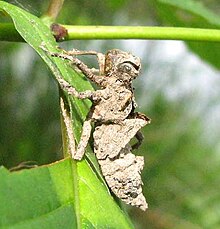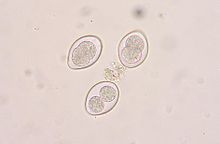Sclerotin
Sclerotins ( ancient Greek σκληρός sklēros "hard") are arthropods ( structural proteins ) solidified by quinone derivatives , which are an essential component in the exoskeleton of arthropods (arthropods such as insects and crustaceans ). In addition to animals (arthropods and flatworms ), they also occur in protists . The deposition of sclerotin causes a solidification of anatomical structures, especially in mechanically highly stressed areas.
Occurrence
In the cuticle of insects, sclerotin usually occurs together with chitin in a proportion of 50 to 70% . Chitin without sclerotin allows flexibility in these areas. In the exoskeleton of marine crustaceans, its proportion is significantly lower, here the storage of calcium salts through calcification provides the necessary strength.
In flatworms it enters the egg shells of flukes and flatworms on, is of the yolk Stock cells (Vitellocyten) of the seed yolk Stocks synthesized. In protists, it is a major component of the protective outer layer of coccidial oocysts .
Sclerotization
During sclerosis, phenol and quinone compounds are covalently bound to amino-rich structural proteins by the enzyme phenol oxidase (such as polyphenol oxidase EC 1.10.3.1 ) . As a result of the sclerotization, the components are polymerized, the matrix thus formed becomes rigid, it can no longer be enzymatically broken down and the other components of the cuticle are embedded in a fixative manner. Sclerotization also involves covalent bonds of the quinones with amino groups of chitin and amino acids of other proteins and leads to a dark coloration of the arthropodins, e.g. B. in the cuticle of beetles .
In the presence of lipids during sclerosis, the insect cuticle acquires water-repellent properties.
literature
- W. Westheide, R. Rieger: Special Zoology. Part 1: Protozoa and invertebrates. 2nd Edition. Spektrum Akademischer Verlag, Heidelberg 2007, ISBN 978-3-8274-1575-2 .
Individual evidence
- ↑ a b c Dieter Bunke: Scerotin components in the vitellocytes of Microdalyellia fairchildi (Turbellaria). In: Journal for Cell Research and Microscopic Anatomy. Volume 135, No. 3, 1972, pp. 383-398.
- ↑ a b H. Börner: Arthropods. In: Plant diseases and plant protection. (= Springer textbook ). 2009, ISBN 978-3-540-49067-8 , Chapter 10, pp. 173-290.
- ↑ Benny Sabroe Welinder: The crustacean cuticle - I. Studies on the composition of the cuticle. In: Comparative Biochemistry and Physiology Part A: Physiology. Volume 47, No. 2, 1974, pp. 779-787.
- ↑ a b K. Ramalingam: Prophenolase and the role of Mehlis' gland in helminths. In: Experientia. Volume 26, No. 8, 1970, pp. 828-828.
- ↑ R. Gönnert: Histological investigations on the fine structure of the egg formation site (oogenotope) of Fasciola hepatica. In: Parasitology Research. Volume 21, No. 6, 1962, pp. 475-492.
- ↑ E. Löser, R. Gönnert: On the formation of the sclerotin envelope of the oocysts of some coccidia. In: Journal of Parasitic Studies. Volume 25, No. 6, 1965, pp. 597-605.
- ↑ Martin G Peter: Chemical modifications of biopolymers by quinone and quinone methides. In: Angewandte Chemie. Volume 101, No. 5, 1989, pp. 572-587. doi: 10.1002 / anie.19891010505
- ^ VB Wigglesworth: Sclerotin and lipid in the waterproofing of the insect cuticle. In: Tissue & Cell . Volume 17, No. 2, 1985, pp. 227-248, doi : 10.1016 / 0040-8166 (85) 90091-6 .

